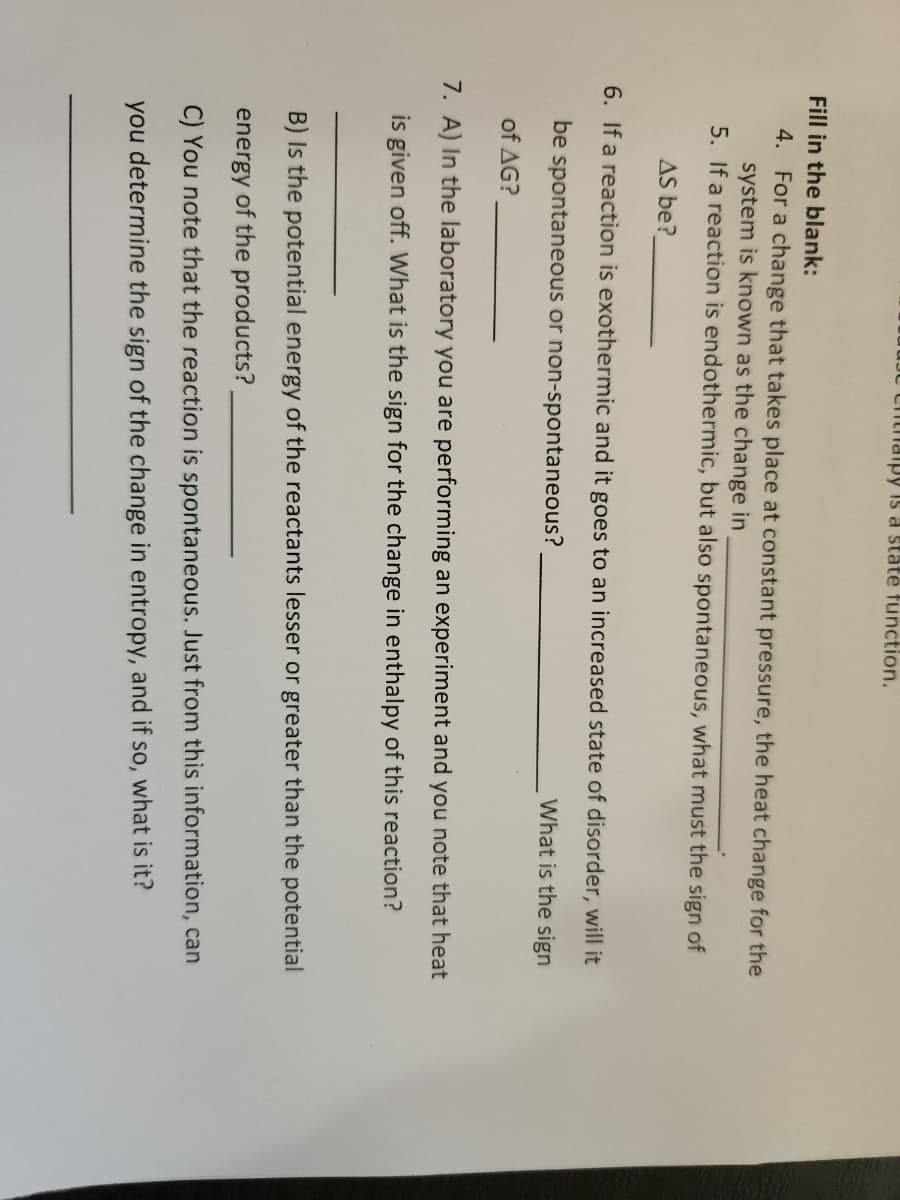enthalpy a state function. Fill in the blank: 4. For a change that takes place at constant pressure, the heat change for system is known as the change in 5. If a reaction is endothermic, but also spontaneous, what must the sign c AS be? 6. If a reaction is exothermic and it goes to an increased state of disorder, wil be spontaneous or non-spontaneous? What is the si of AG? 7. A) In the laboratory you are performing an experiment and you note that F is given off. What is the sign for the change in enthalpy of this reaction? B) Is the potential energy of the reactants lesser or greater than the poten energy of the products? C) You note that the reaction is spontaneous. Just from this information, c you determine the sign of the change in entropy, and if so, what is it?
enthalpy a state function. Fill in the blank: 4. For a change that takes place at constant pressure, the heat change for system is known as the change in 5. If a reaction is endothermic, but also spontaneous, what must the sign c AS be? 6. If a reaction is exothermic and it goes to an increased state of disorder, wil be spontaneous or non-spontaneous? What is the si of AG? 7. A) In the laboratory you are performing an experiment and you note that F is given off. What is the sign for the change in enthalpy of this reaction? B) Is the potential energy of the reactants lesser or greater than the poten energy of the products? C) You note that the reaction is spontaneous. Just from this information, c you determine the sign of the change in entropy, and if so, what is it?
Chemistry for Engineering Students
4th Edition
ISBN:9781337398909
Author:Lawrence S. Brown, Tom Holme
Publisher:Lawrence S. Brown, Tom Holme
Chapter10: Entropy And The Second Law Of Thermodynamics
Section: Chapter Questions
Problem 10.50PAE: For the reaction NO(g)+NO2(g)N2O3(g) , use tabulated thermodynamic data to calculate H and S. Then...
Related questions
Question
100%
4,5,6,7 plz

Transcribed Image Text:- enthalpy is a state function.
Fill in the blank:
4. For a change that takes place at constant pressure, the heat change for the
system is known as the change in
5.
If a reaction is endothermic, but also spontaneous, what must the sign of
AS be?
6. If a reaction is exothermic and it goes to an increased state of disorder, will it
be spontaneous or non-spontaneous?
What is the sign
of AG?
7. A) In the laboratory you are performing an experiment and you note that heat
is given off. What is the sign for the change in enthalpy of this reaction?
B) Is the potential energy of the reactants lesser or greater than the potential
energy of the products?
C) You note that the reaction is spontaneous. Just from this information, can
you determine the sign of the change in entropy, and if so, what is it?
Expert Solution
This question has been solved!
Explore an expertly crafted, step-by-step solution for a thorough understanding of key concepts.
This is a popular solution!
Trending now
This is a popular solution!
Step by step
Solved in 2 steps with 2 images

Knowledge Booster
Learn more about
Need a deep-dive on the concept behind this application? Look no further. Learn more about this topic, chemistry and related others by exploring similar questions and additional content below.Recommended textbooks for you

Chemistry for Engineering Students
Chemistry
ISBN:
9781337398909
Author:
Lawrence S. Brown, Tom Holme
Publisher:
Cengage Learning

Chemistry: The Molecular Science
Chemistry
ISBN:
9781285199047
Author:
John W. Moore, Conrad L. Stanitski
Publisher:
Cengage Learning

Chemistry: An Atoms First Approach
Chemistry
ISBN:
9781305079243
Author:
Steven S. Zumdahl, Susan A. Zumdahl
Publisher:
Cengage Learning

Chemistry for Engineering Students
Chemistry
ISBN:
9781337398909
Author:
Lawrence S. Brown, Tom Holme
Publisher:
Cengage Learning

Chemistry: The Molecular Science
Chemistry
ISBN:
9781285199047
Author:
John W. Moore, Conrad L. Stanitski
Publisher:
Cengage Learning

Chemistry: An Atoms First Approach
Chemistry
ISBN:
9781305079243
Author:
Steven S. Zumdahl, Susan A. Zumdahl
Publisher:
Cengage Learning

Chemistry
Chemistry
ISBN:
9781305957404
Author:
Steven S. Zumdahl, Susan A. Zumdahl, Donald J. DeCoste
Publisher:
Cengage Learning


General Chemistry - Standalone book (MindTap Cour…
Chemistry
ISBN:
9781305580343
Author:
Steven D. Gammon, Ebbing, Darrell Ebbing, Steven D., Darrell; Gammon, Darrell Ebbing; Steven D. Gammon, Darrell D.; Gammon, Ebbing; Steven D. Gammon; Darrell
Publisher:
Cengage Learning